Ruaha National Park Travel Guide: A Journey into Tanzania's Untamed Heart
Ruaha National Park is one of the largest national parks in Tanzania and It also offers a one-of-a-kind safari experience in East Africa. Once experienced, few would want to choose another destination due to its unmatched wilderness. Ruaha is a rugged and remote wilderness area in the South-central region of the county, which is marked out by the towering baobab trees, rocky escarpments, and the Great Ruaha River, which is described as a source of life.
Providing a truly off-the-tourist-map experience, Ruaha has long been a destination notorious for its low levels of visitor traffic as well as its outstanding spotting encounters with predators of all kinds, including one of the largest populations of lions in Africa and significant remaining packs of the elusive African wild dog
It is where the East African savannah blends perfectly with the Southern African bush to allow a perfect ecological synergism and an unfiltered immersion into the wilderness for those who want a memorable experience of a real and raw safari. This travel guide will provide you with the best months to visit, how to access this national park, the best activities, and the most amazing attractions that make Ruaha a fascinating national park in Africa.
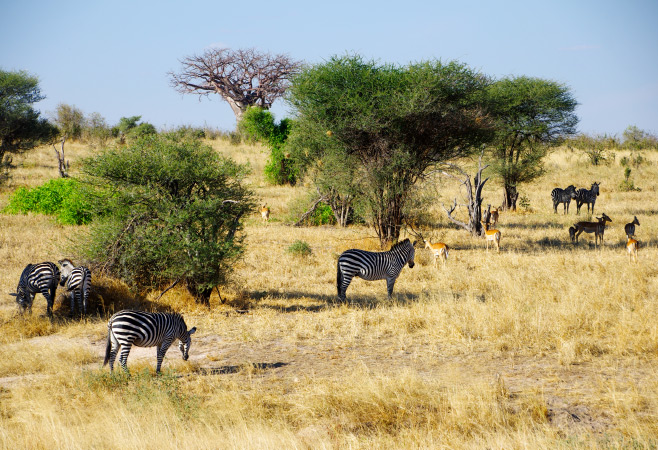 Ruaha National Park is one of Tanzania’s most remarkable and lesser-known safari destinations
Ruaha National Park is one of Tanzania’s most remarkable and lesser-known safari destinations
- Get to Know Ruaha National Park: Key Information for an Unforgettable Experience
- How to get to Ruaha National Park
- By Road (Budget-Friendly Option)
- By Bus (Cheapest Option)
- Private Safari Tours
- Top things to do in Ruaha National Park
- Where to stay in Ruaha National Park
- Travel Tips for Ruaha National Park
- Conclusion
Get to Know Ruaha National Park: Key Information for an Unforgettable Experience
Where is Ruaha National Park located?
Ruaha is approximately 130 km (80 mi) southwest of Iringa town. In particular, it is positioned in the central-southern area of the country, but it is a constituent of the Southern Safari Circuit, which is extensive. Ruaha is located about 130 kilometers west of Iringa, which serves as the park’s main gateway
Geographically, Ruaha is simply mesmerizing in its topography and spans the Great Rift Valley to include grassy hills, open savannah terrain, rocky cliffs, and deep river thickets. It has a river named the Great Ruaha River within its boundaries, which is nourished by the Great Ruaha River, a vital water source for the park's wildlife
While still far less visited than the northern parks, Ruaha has seen increasing attention from seasoned safari-goers looking for a more remote and exclusive experience. It remains one of the largest protected areas in Tanzania and offers a wild, off-the-beaten-track safari atmosphere compared to the busier Serengeti or Ngorongoro.
Best time to visit Ruaha National Park
Ruaha National Park is best visited from the month of June to October when the weather is dry.
Pros: The wildlife is concentrated along the Great Ruaha River and along its tributaries thus game viewing is very predictable and pleasant. The bushes are not dense and this enhances visibility. The climate is sunny and cool in general.
Cons: September and October during the day can be very hot, very dry and dusty.
November to May is the wet season and provides a spectacular season of lush green growth and is the best season to do bird watching, but the roads are often in bad repair and wildlife is scattered. In the case that you want to spot big mammals and predatory animals then the dry season takes the cake
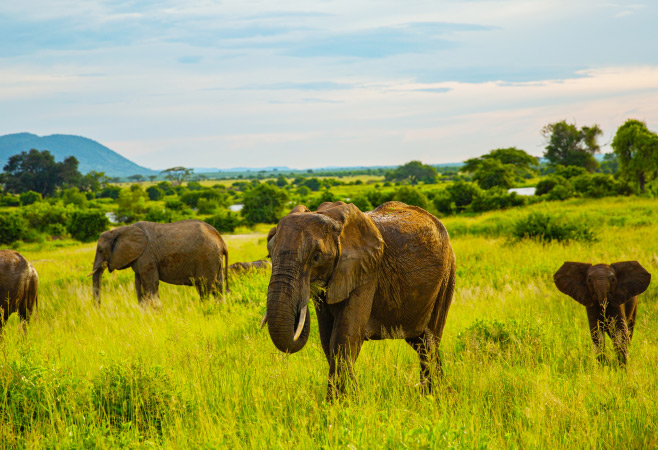
This period offers the most favourable conditions for wildlife viewing and safari experiences
Ruaha National Park fees and opening hours for travelers
Entry Fees (Per Person)
|
Visitor Category |
Duration |
Fee (USD) |
Notes |
| International Adult (16+ years) | 1 day | $30 | Valid for 24 hours |
| 3 days | $40 | Valid for 3 consecutive days | |
| 7 days | $60 | Valid for 7 consecutive days | |
| International Child (5–15 years) | 1 day | $10 | Children under 5 enter free |
| Tanzanian Resident Adult (16+ years) | 1 day | 5,000 TZS | Valid for 24 hours |
| Tanzanian Resident Child (5–15 years) | 1 day | 2,000 TZS | Children under 5 enter free |
Park entry fees may vary annually. It’s recommended to confirm the latest rates on the official TANAPA website before traveling.
Vehicle Fees
|
Vehicle Type |
Fee (USD / TZS) |
Notes |
| Vehicles under 2,000 kg | $40 or 20,000 TZS | Per vehicle per entry |
Other Fees
|
Activity |
Fee (USD / TZS) |
Notes |
| Public Campsite (per person/night) | $30 or 10,000 TZS | |
| Special Campsite (per person/night) | $50 or 20,000 TZS | |
| Walking Safari (1–4 hours) | $20 or 5,000 TZS | Per person |
| Walking Safari (over 4 hours) | $25 or 10,000 TZS | Per person |
| Guided Game Drive | $20 or 5,000 TZS | Per person |
| Night Game Drive | $50 or 10,000 TZS | Per person |
Opening hours
Ruaha National Park operates daily from 6:00 AM to 7:00 PM, including weekends and public holidays.
These working hours are applicable on all the gates of entrances, including Msembe, Jongomero, Mdonya, and Idodi. These hours apply daily, including weekends and public holidays, ensuring visitors have a safe and pleasant experience
Travel Tips:
- Early Morning Game Drives: Starting your safari early increases the chances of witnessing active wildlife.
- Plan Ahead: Ensure you have ample time to explore and exit the park before closing time.
Entrance Gates of Ruaha National Park
When you are on a safari in Ruaha National Park, you should always select the right gate to get into the park. All the gates will give a different view of the park and a view to various areas, habitats, and wildlife. This is a complete travel guide to the entrance gates of Ruaha National Park:
1. Msembe Gate:
Msembe gate located on the eastern side of the park is the main entry gate of the Ruaha National park. The gate is present in a region that can be easily reached by the town of Iringa and it is considered a key point of most of the tourist safari tours. The main section and the southern part of the park can be accessed by Msembe Gate and here tourists can get a high density of wildlife.
2. Jongomero Gate:
Jongomero Gate is located in the south region of Ruaha National Park and it is the gate that serves the least explored and developed parts of the park. This is especially the gate of choice of the people who want to get a more off the beaten path experience and a possibility of venturing into the wilderness on their own.
3. Mdonya Gate:
Mdonya Gate is in the western side of the park that offers access to the scrubby land and riverine woodlands of Ruaha National Park. This gate is a good entry point as one will find his/her way through exploring scenarios of the western plains and sightings of a wide variety of wildlife, such as elephants, buffalo, as well as antelope.
4. Idodi Gate:
Although Idodi is not an official TANAPA gate, it is a commonly used access point for travelers entering from the northern routes or nearby local villages. Located in the north of Ruaha National Park, Idodi Gate provides entry to the beautiful scenery of the park, which has a variety of habitats. This gate has enabled tourists to visit the northern plains and forests, where different species of birds and predators exist.
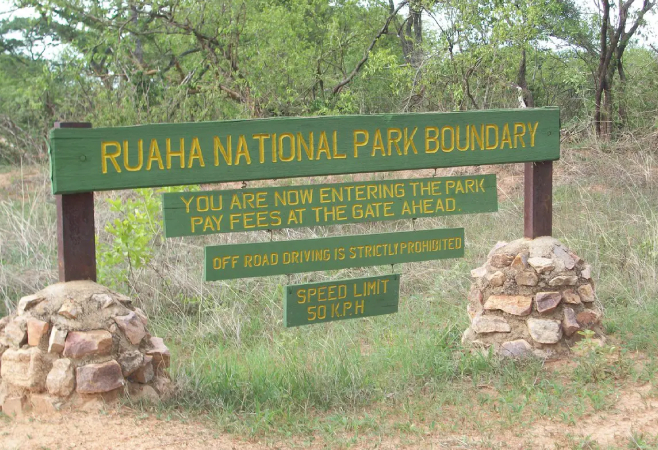
Ruaha National Park boasts four entrance gates, each offering unique access points to the diverse landscapes and wildlife within the park
How to get to Ruaha National Park
Located deep in the south of Tanzania, Ruaha National Park can only be described as a breathtaking wilderness full of wildlife and some dramatic landscapes and also as a dream destination where getting off the beaten path to enjoy a safari is feasible. Even though Ruaha is extremely remote, reaching the park is very possible; you can fly there to be comfortable or drive and have fun. Here are some of the best ways to travel to Ruaha National Park
By Air (Fastest Option)
Domestic Flights:
- Daily scheduled flights operate from major cities like Dar es Salaam, Arusha, and Zanzibar to Msembe Airstrip inside Ruaha National Park.
- Airlines like Coastal Aviation, Auric Air, and Safari Airlink serve this route.
- Flight time:
- From Dar es Salaam: approx. 2–2.5 hours
- From Arusha: approx. 3–4 hours
Benefits:
- Saves time, especially if your itinerary covers multiple parks.
- Stunning aerial views of Tanzania’s landscapes.
Tip: Book flights well in advance during high season (July–October).
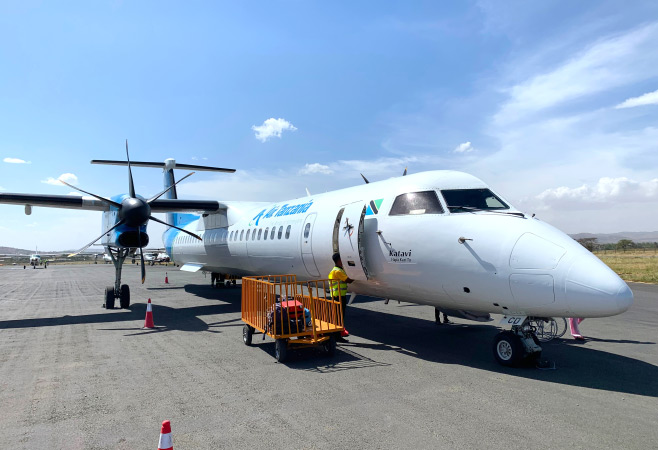
The most convenient and efficient way to access Ruaha National Park is by air.
By Road (Budget-Friendly Option)
Ruaha is accessible via road from Iringa town, which lies about 130 km (approx. 80 miles) away.
- From Dar es Salaam → Iringa:
- Distance: ~500–600 km
- Duration: 8–10 hours by private car or bus
- From Iringa → Ruaha National Park:
- Distance: ~130 km
- Duration: 2.5–3.5 hours
- Road: Part tarmac, part gravel (can be rough, especially in rainy season)
Tip: A 4×4 vehicle is highly recommended due to sections of rough road and possible muddy conditions.
By Bus (Cheapest Option)
- You can take a long-distance bus from Dar es Salaam to Iringa.
- From Iringa, arrange:
- A private transfer
- A local safari tour
- Or hire a vehicle to continue to the park
Downside:
- Long journey
- Less flexible schedules
- No direct buses to the park itself
Private Safari Tours
Many tour operators offer full safari packages including:
- Transport from Dar es Salaam, Arusha, or Iringa
- Park entry fees
- Accommodation and guided game drives
Benefits:
- Hassle-free travel
- Local expertise
- Often better value than arranging everything separately
Travel Notes:
- Roads into Ruaha can become impassable in heavy rains (especially March–May).
- Always check with operators for current conditions.
- Park opening hours are 6:00 AM – 7:00 PM.
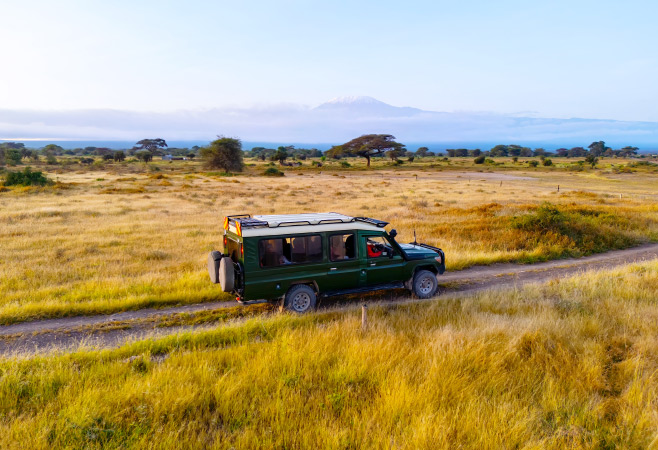
To reach Ruaha National Park by road, you can start from Iringa town
Top things to do in Ruaha National Park
Ruaha National Park is perhaps one of the best-kept secrets of Tanzania—the one that is wild, unspoiled, and full of picturesque vistas and biodiversity beyond imagination. It is the largest park, measuring approximately 20,226 square kilometers, where one can experience a less commercialized, out-of-the-way safari. Whether you are an experienced safari enthusiast or a first-time adventurer, you will not regret doing any of the top things to do in the Ruaha National Park
Go on a Classic Game Drive
A classic game drive is the core of any visit to Ruaha National Park. Driving on bumpy roads which twist through the baobab studded plains, forests, and rocky mountains, you will feel amazed by the variety of wildlife. Ruaha also possesses one of the highest density of elephants in East African, together with a good number of lions, leopards, cheetahs and some rare species of antelopes such as sable and roans.
The best time to go is in the morning and the late afternoons as they seem cooler and one can always have the best opportunity of seeing predators on mark, or herds around the great Ruaha River.
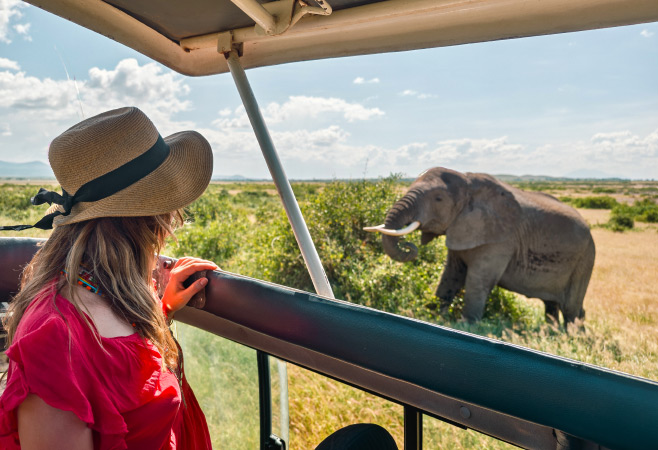
The park offers both morning and afternoon Game Drives, allowing visitors to observe a wide array of wildlife
Experience a Ruaha Walking Safari
A walking safari in Ruaha is something that a traveler will not want to miss in case you want to connect with nature. The walks are accompanied by armed rangers and guides who are well conversant with the park, and it sends one behind the scenes, where one gets to see details that would not be obtained by land.
Bush also surprises you when you are walking on your way. You will discover how to read tracks on the dust, know the calling of birds placing their nests on the acacia trees, and know how to identify the medicinal plants that have been used by the locals over an extended period. Among the exclusive opportunities that the Ruaha walking safari offers is an opportunity to encounter wildlife at a vulnerable proximity that is virtually created to give a sense of cognition and realization of the fragile existence of this ecological habitat.
Walking safaris can take between an hour and several hours, and they can be tailored to different fitness levels, often revealing hidden treasures: a waterhole of whichmost visitors don’t even know about yet: the kudu have discovered it; a termite mound of living interest; a pride of lions crouched and glaring from the tall grasses. It’s a thrilling and humbling experience that stays with travelers long after their journey ends
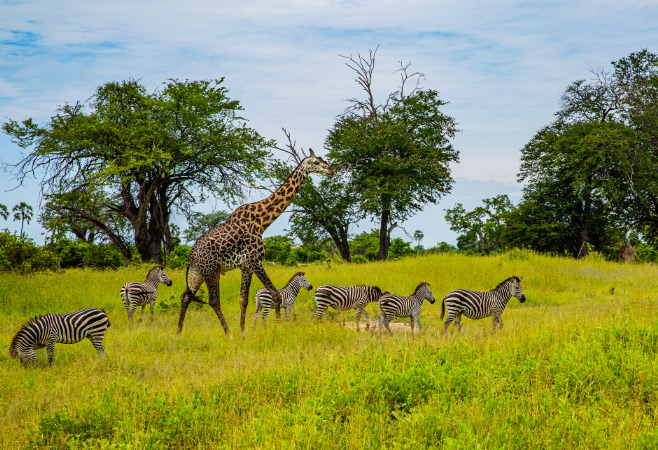
Guided walking safaris provides an intimate and immersive wildlife experience, allowing visitors to explore the park on foot
Marvel at Birdwatching Paradise
Ruaha National Park is a paradise for people who love birds because it has more than 570 species of birds. The birds are simply spectacular including vibrant lilac-breasted rollers and colorful bee-eaters, as well as magnificent bateleur eagles, and the birdlife is both numerous and diverse.
In the wet season (November to April) the migratory birds fly in, and Ruaha becomes a bird spectacle. Bring binoculars and a field guide; you will see everything from small sunbirds to mighty raptors soaring overhead.
Visit the Great Ruaha River
The Great Ruaha River, the lifeline of the park, flows throughout it, and the animals come throughout the year. Riverbank game drives are good and offer great viewing of hippos wallowing in pools, crocodiles sunbathing on sandy banks, and elephants in the process of drinking or crossing the river.
The dry season transforms the river into an attraction to both the predator and prey, due to which the wildlife action occurs splendidly in front of your eyes.
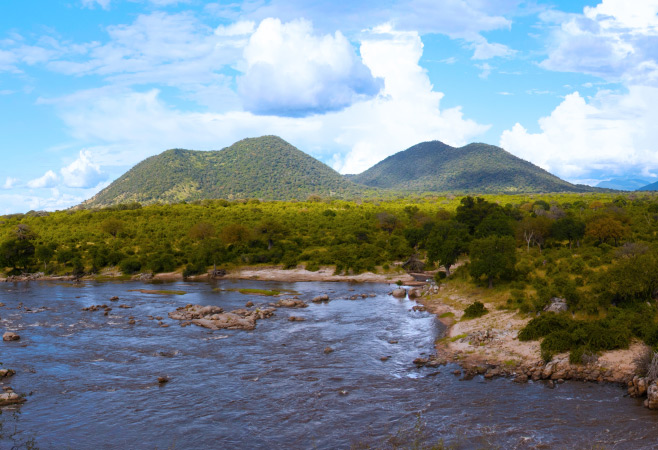
The Great Ruaha River runs through Ruaha National Park, serving as a vital water source that attracts a wide variety of wildlife
Enjoy Night Game Drives
Night game drives in Ruaha offer a rare opportunity to witness the park’s after-dark wildlife. They are available only through select lodges with special TANAPA permits and are not a standard offering in all camps, making them far less common than daytime safaris or night drives in parks like Serengeti or Tarangire.
During these trips, one discovers a strange, new world of after-dark animals: bush babies, genets, civets, and even such elusive predators as leopards on the powl. It is a night with electricity in the air, as something is being sighted out in the darkness with the aid of a spotlight. Your guide is able to see the glowing eyes and the unseen activity.
Photograph Giant Baobabs and Scenic Landscapes
The landscape at Ruaha is spectacular, just like its wildlife. Wide plains dotted with old baobab trees, rocky kopjes with spectacular views, and golden sunsets create a constantly shifting background. Amateur photographers will never run out of stimuli, including taking pictures of the silhouette of a giraffe against the background of a burning sky or of arid riverbeds.
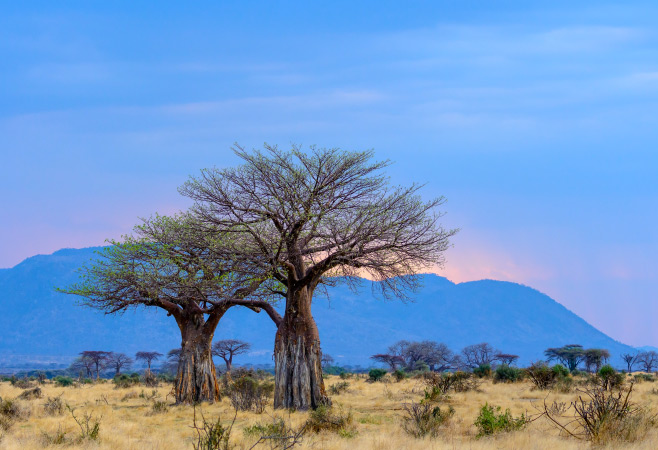
The Baobab Valley is characterized by its enchanting landscape adorned with iconic baobab trees.
Immerse in Cultural Experiences
Ruaha National Park is not just all wildlife; it is also fused with indigenous cultures. Most lodges organize cultural tours of other villages nearby, so tourists can learn about the cultures of the Hehe and Bena tribes. You may watch people do their traditional dance, visit local markets, and learn how craft workers make tools, baskets, and pottery.
These visits make your safari more elaborate, allowing you to look into the lives of the people living around this wild area.
Stay at Safari Camps
Where you stay is a great part of the Ruaha experience. The park is lined up with small, exotic safari camps that present fantastic vistas, outdoor lounges, and tented rooms. There are also personalized services, excellent cuisine, and guides who have extensive knowledge of the area and make your adventure special at times, which are included in these lodges.
Nothing beats the sense of waking up to the distant roar of lions or going to bed to the gentle murmur of a herd of elephants through the camp; a stay at Ruaha immerses you in the wild while offering touches of luxury
Where to stay in Ruaha National Park
The Ruaha National Park is a fabulous place that brings a fantastic variety of succulent resorts that suit various tastes and budgets so that the guests who visit and enjoy the wild beauty of Tanzania are ensured of a comfortable stay. Do you prefer rustic simplicity or luxurious comfort? For the memory of a lifetime, you will find places to stay in this great wilderness in Tanzania.
Luxury Lodges
Visitors who have some slices of urbanity in the bush can enjoy a view, room space, and high service level in several luxurious lodges. Places such as Jabali Ridge and Ikuka Safari Camp are famous for chic design, infinity-edged pools that overlook the sweeping plains, delectable cuisine, and dining decks that allow people to view the elephants strolling by. Such lodges usually have guided game drives, walking safaris, and personal kinds of service so that your stay is unique.
Mid-Range Camps
Visitors on a budget who want comfortable accommodation will fall hopelessly in love with the greats in the middle-range accommodation in Ruaha, e.g., The Ruaha River Lodge is located alongside the Great Ruaha River, and there are lovely stone cottages with verandas overlooking the water. Visitors get to savor filling food, warm welcomes, and great wildlife sightings in camp.
Tented Camps
To get the true safari feeling, trekking camps such as Kwihala Camp offer a personal camping experience under canvas. These camps add the thrill of camping near nature with amazingly comfortable beds, hot showers, and exquisite food. When it is night, you will go to sleep hearing lions roar or hyenas call in the distance.
Budget Options
Although Ruaha is often associated with the higher accommodation costs, budget travelers can still find affordable campsites or the simple bandas (cabins) along the borders of the park, particularly in the town of Iringa. Living outside the park may result in increasing the number of kilometers traveled per day, but it also offers an opportunity to enjoy the wonders of Ruaha on a budget.
Regardless of where you will stay, Ruaha National Park is a place where you will wish to relive your safari experience, as it represents the rugged wilderness mixed with the cordial Tanzanian spirit.
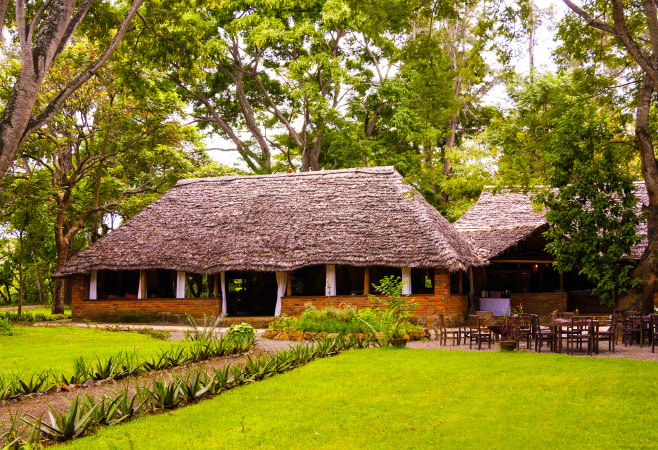
Accommodation in Ruaha National Park ranges from luxury lodges to budget-friendly camps
Travel Tips for Ruaha National Park
A safari trip in Ruaha National Park promises to be an unforgettable adventure. To get the best out of your trip, you may want to use these useful travel tips:
Travel Documents
- Make your passport valid at least six months past your tentative travel date.
- The majority of visitors need a Tanzanian visa, which could be requested online by using the eVisa system or can be applied for when landing at some of the entrance channels. Nevertheless, please check the regulations now, because rules may vary.
- Print out and save copies of key documents, including your passport, visa, your travel insurance, and booking documents.
- A yellow fever vaccination certificate might be necessary in case you are entering the country, which is a yellow fever endemic country, or even transiting through it.
Pack Smart
- Game driving clothes in neutral colors. Insects may be attracted to bright colors, or animals may be scared.
- Strong sun, sunglasses, sunscreen, and a good hat.
- A pair of binoculars to see wildlife and a camera with a zoom lens to photograph wildlife that is long distances away.
- You might need warm clothes to wear on early morning and early evening drives, as it could turn out cool at times.
- Insect repellent, particularly in the wetter seasons.
Park entries/permits
Fees of entry differ in nationality and the number of days a foreigner stays. Costs are good to verify beforehand, and bring a credit card, since nowadays, a large number of parks accept cashless settlements.
Stay Hydrated and Healthy
Take lots of bottled or purified water. Before traveling, consult your doctor concerning vaccinations and malaria prophylaxis.
Wildlife and Guides Respect
Watch out not to get too close to the animals, and be obedient to what your guide says. Ruaha is wild and untameable—respect for it guarantees safety and maintenance of its magic in the park.
Mobile Connectivity and eSIMs
The cellular signal in the Ruaha National Park is only available in a few areas, with poor or no signal in remote regions of the park. Mobile coverage inside Ruaha is extremely limited to nonexistent. While an eSIM may be useful in Iringa or en route, don’t rely on mobile data once inside the park
Many travelers should consider buying a Tanzania eSIM. Tanzanian data plans are offered by such eSIM providers as Airalo, Holafly, and Nomad, and they can be purchased online and activated immediately. This eliminates the need to find a physical SIM card on arrival. Plans can be as low as $9–$15 USD for a few gigabytes, depending on the volume of the data, and data volumes over 20 GB might not have a plan. Always check that your phone supports eSIM technology before purchase.
Local networks (including Vodacom, Airtel, and Tigo) can be used as well and would be a good bet if you prefer a physical SIM; otherwise, they have limited coverage in and around major towns (including Iringa) and even on main roads
Conclusion
Ruaha National Park is a destination for the true safari enthusiast. It is a place of dramatic landscapes, massive elephant herds, and intense predator action, offering a raw, authentic, and unforgettable experience of Africa’s wilderness. If you seek solitude and a deep connection with nature, Ruaha is Tanzania's wild heart waiting to be discovered.
Related Articles
- Top 15 Churches To Visit in Tanzania That Blend Beauty and History
- The Great Migration Tanzania Safari: A Complete Guide to the World’s Greatest Wildlife Show
- Ultimate Mtwara Tanzania Travel Guide: Best Things to Do and How to Plan Your Trip
- Tanzania Family Holiday Guide: Creating Memories That Last a Lifetime
- Tanzania Tourist e-Visa for First-Time Travelers: A Complete Online Application Guide











